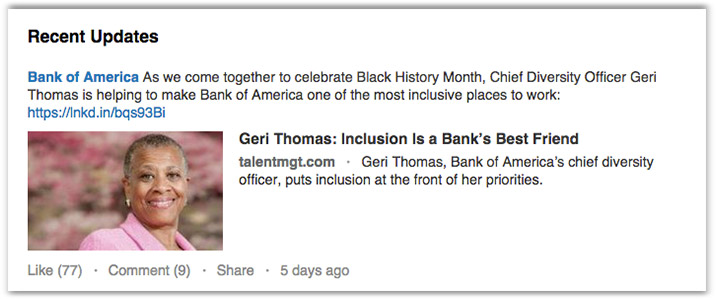6 Ways to Optimize Your Company’s LinkedIn Profile
It’s hard to pinpoint the moment LinkedIn began its evolution from a schmoozy cocktail party for HR recruiters and job applicants to the premier social network for consuming and sharing professional content.
Maybe it was back in 2012 when it acquired SlideShare, but last year – when LinkedIn launched its Influencer Program (which features posts from the likes of Richard Branson, Jack Welch, and Bill Gates) – it was clear that what has long been considered the stodgiest social media channel has become a place where companies of all sizes can find new customers, demonstrate thought leadership, and market their businesses better.
![]()
1. Create a more engaging “About” section

Your profile is the heart and soul of your LinkedIn business brand, but most are extremely boring and convey no value propositions or compelling attributes. To keep up with the social media trends spearheaded by Facebook and Pinterest, LinkedIn has become more visual.
You now have the ability to tell your company’s story using rich, visual content, which means you can upload images, videos, presentations and more. From the analyst who makes annual predictions on tech trends to the 3D printing company looking to demonstrate a new product, the opportunities to differentiate yourself are limitless.
2. Publish Useful, Relevant Content

At a LinkedIn conference last year, Eileen Loustau, BlackRock’s Global Director of Social Media, estimated that LinkedIn was driving $17-18 million dollars of revenue for the financial investment company due to the financial advice BlackRock shares on their LinkedIn Page.
In addition to Influencers, any company can now publish long-form posts about its expertise and insights. Here’s how the LinkedIn content engine works:
- Your original content becomes part of your professional profile. It is displayed on the Posts section of your LinkedIn profile.
- It’s shared with your connections and followers.
- Members not in your network can now follow you from your long-form post to receive updates when you publish next.
- Your long-form post is searchable both on and off of LinkedIn.
3. Share Links

Many companies like to share accomplishments, new products, and press releases on their social media sites. However, consider using LinkedIn as a platform for blog posts and articles that aren’t necessarily written by you. In other words, make your brand a hotspot for industry news, valuable information, and knowledge in your field.
4. Feature Your Employees
People want to see the faces that are behind your brand, which is why showcasing employees makes your company more personable and allows visitors to check out their pages as well. Remember, potential customers might be more likely to connect with the profile of an employee than the business itself.
5. Create a LinkedIn Group
LinkedIn groups function as independent social networks for niche audiences where you can spread your message, connect with key partners, and take your business to another level. There are benefits to joining niche-related groups, and while most professionals and brands join groups for exposure, why not create your own? This truly establishes you as a thought-leader and as the group grows, so does your authority, but make sure you strike the right balance between self-promotional content and content that adds value to the discussion like industry news, best practices, new ideas, etc.
Here are some tips for success:
- Define your target audience first. Who are your prospects? And what are their core problems?
- Before you go live, make sure to post interesting articles and conversation starters in the group. This will impress your first batch of members and get the conversation going.
- Once you have built some initial activity, start inviting your business prospects to join the group. You can do this via LinkedIn paid media such as LinkedIn Ads, or Inmails, which allow you to send personalized one-to-one invitations.
- Promote regular conversations around the group’s topics to grow discussion threads.
- Never sell or self-promote in your group. Instead, engage in social selling by providing no-strings-attached value to your members via expert advice and information.
6. Analyze your Investment
LinkedIn enhanced their Company Page analytics in mid-2014, and now offers a breakdown of company page analyses according to three main categories: Updates, Followers, and Visitors. In addition to monitoring traffic and various insights, you can also compare your company’s performance to its competition.
Take a look at your current metrics and record your baseline numbers in each category. Then set some goals to increase those numbers across the board. And don’t be afraid to experiment with different kinds of posts until you figure out what your audience wants.





